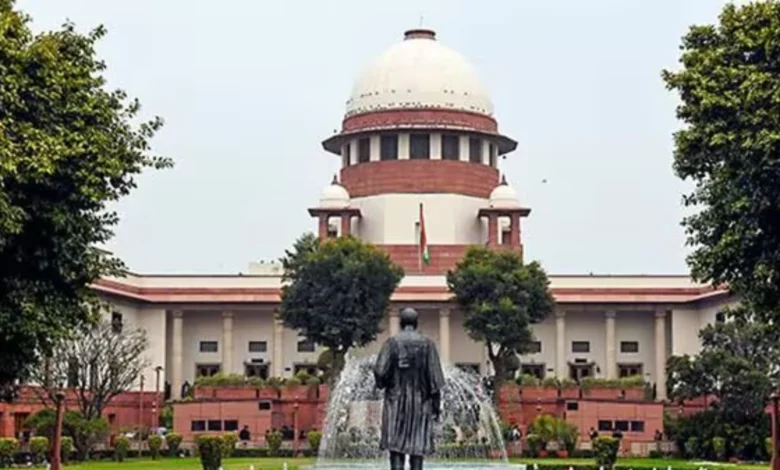Vijaya Bank Fraud Case Update: Supreme Court Acquits Jeweller in Rs 6.7 Crore Vijaya Bank Fraud Case

| ➡️ Get instant news updates on Whatsapp. Click here to join our Whatsapp Group. |
More than 27 years after the Central Bureau of Investigation (CBI) began its probe into a high-profile bank fraud case involving Vijaya Bank, the Supreme Court has ruled in favor of the last remaining accused, a jeweler named Nandkumar Babulal Soni. The court found that the investigation was based on suspicion rather than concrete evidence. As a result, Soni was acquitted, and the court ordered that 205 gold bars, which were seized from him as “stolen property,” be returned.
Supreme Court Questions CBI’s Investigation
A three-judge bench led by Justice Bhushan R. Gavai emphasized that suspicion, no matter how strong, cannot replace solid proof in a legal case. The CBI had charged Soni under Section 411 of the Indian Penal Code (IPC), which applies when a person is found in possession of stolen property and knowingly retains it. However, the Supreme Court found that the CBI had failed to prove two key elements:
- The seized gold bars were actually stolen property.
- Soni was aware that the gold bars were stolen.
Because these essential points were not established, the court ruled in Soni’s favor and overturned the Bombay High Court’s July 2009 judgment, which had convicted him under Section 120B (criminal conspiracy) read with Section 411 IPC. These charges could have led to a maximum punishment of three years in prison.
Key Observations by the Supreme Court
The Supreme Court, which also included Justices Prashant Kumar Mishra and K.V. Viswanathan, was critical of how the CBI handled the case. It stated that the prosecution had “utterly failed” to prove its case beyond reasonable doubt.
Justice Mishra questioned how Soni could be convicted when lower courts had already determined that the seized gold bars were not the same as the ones allegedly stolen. He pointed out that if the gold was not proven to be stolen, charges under Sections 120B and 411 IPC could not stand.
Background of the Vijaya Bank Fraud Case
The case dates back to September 1997, when Vijaya Bank reported a fraud involving an account held by M/s Globe International. The fraud was committed through fake Telegraphic Transfers (TTs) sent from the bank’s Delhi branch to its Nashik branch.
- These fake transfers resulted in payments being credited to the account, allowing Globe International to withdraw ₹6.70 crore before the fraud was detected.
- When the Nashik branch manager realized the TTs were fraudulent, the bank stopped processing further transfers worth ₹1.61 crore and reported the case to authorities.
- The CBI launched an investigation and found that the account was opened using forged documents. The person who opened the account had disappeared.
The Accused and the Legal Battle
The CBI charged four people, including:
- Two bank officials who were accused of facilitating the fraudulent account opening.
- Mukesh Shah, who was associated with Globe International and allegedly involved in the fraud.
- Nandkumar Babulal Soni, a jeweler who allegedly received gold bars from Mukesh Shah.
However, Mukesh Shah was never tried as he remained absconding.
- The trial court convicted all three accused but ordered the return of the 205 gold bars to Soni.
- The Bombay High Court later acquitted the bank officials but convicted Soni under Section 411 IPC. It also ruled that the gold bars should remain in the state’s custody.
- Soni challenged this decision in the Supreme Court in 2012, and Vijaya Bank also filed an appeal demanding the return of the gold bars.
Supreme Court’s Final Verdict
The Supreme Court found that the CBI had recovered the gold bars in 2001, almost four years after the fraud was discovered. However, the CBI could not prove that these gold bars were the same as those linked to the fraudulent transactions.
The court pointed out that even if it was proven that Soni had received demand drafts from Mukesh Shah and bought gold bars from M/s Chenaji Narsinghji and M/s V.P. Jewellers, this did not automatically make the gold “stolen property.” The prosecution failed to prove that Soni knew the gold was linked to fraudulent activities.
Additionally, the court noted that Soni was charged only for receiving stolen property (Section 411 IPC) and criminal conspiracy (Section 120B IPC), not for his involvement in the fraudulent TTs. The High Court, while convicting Soni, argued that he failed to prove that he had lawfully acquired the gold.
Rejecting this reasoning, the Supreme Court stated:
“We fail to understand how the appellant is required to prove lawful acquisition of gold when the prosecution itself failed to prove that the gold was stolen.”
The court concluded that to convict someone under Section 411 IPC, the prosecution must prove three things:
- The accused had possession of stolen property.
- Someone else had previous possession of the stolen property.
- The accused knew that the property was stolen.
Since the CBI failed to establish these conditions, the Supreme Court acquitted Soni and ordered the return of the 205 gold bars to him.
Conclusion
The Supreme Court’s ruling highlights serious lapses in the CBI’s investigation, where suspicion took precedence over solid proof. The case serves as a reminder that in the judicial system, strong evidence is necessary to secure a conviction, and mere allegations or circumstantial links are not enough. With this verdict, Soni is now cleared of all charges, bringing an end to a 27-year-long legal battle.
